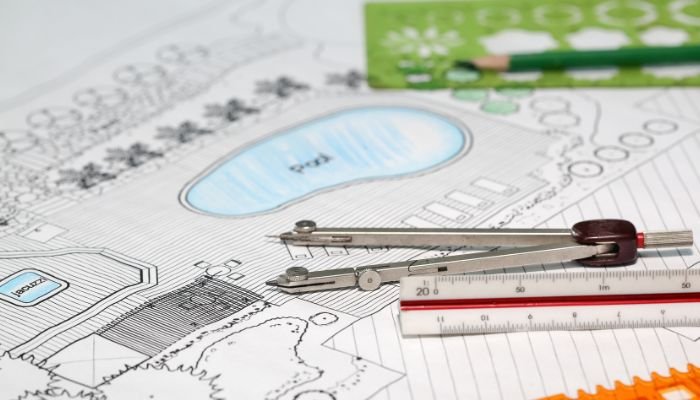Architects work with drafters to create everything from conceptual drawings to detailed construction documents. They collaborate with construction firms to develop and maintain building plans, maps, charts, and drawings. Typical workplace settings for drafters include architectural firms and building companies, although occasional site visits may be necessary. This field is suitable for individuals who can think critically and have an interest in engineering and building construction. The drafter must understand how to effectively utilize the software for architectural communication.
Also, Read What Is Architecture? | Building a Modern Era
Table of Contents
What Is an Architectural Drafter?
The job of an architectural drafter is to prepare construction drawings and blueprints. They take the information provided by architects and engineers and use it to complete the necessary technical drawings. Drafters should have experience with computer-aided design (CAD) software, as this is the primary tool used in the industry. Throughout the design process, drafters work closely with architects and engineers to double-check requirements, materials, and other information that is crucial to the project’s success.
A draftsman in the field of architecture uses various computer programs to produce technical drawings, blueprints, and plans of architects’ conceptual conceptions. They can achieve this because of their significant training and knowledge of CAD software.
Read: How to Become a CAD Designer
Architectural drafters collaborate with architects and engineers to verify project requirements and design details. When the technical drawings and blueprints for a building are complete, they are sent to the construction or project managers so that they can be used during construction. Architectural drafters create plans for new buildings by drawing their blueprints. Some of these employees may focus exclusively on commercial or residential buildings. Construction materials like steel, wood, and reinforced concrete could also lead to specialization.
Read Engineering vs Architecture: Which Is Superior?
What Does an Architectural Drafter Do?
Architectural drafters create precise construction designs using specialized software. They develop an architect’s preliminary sketches or conceptions into detailed plans that outline every step of the construction process. Working as an architectural drafter requires you to do things like:
- Read and understand blueprints and project specifications.
- Use a CAD program to create 2D and 3D construction drawings.
- Notify the rest of the team of any design issues.
- Review completed drawings to ensure they comply with building codes and regulations.
- Talk to clients and contractors.
- Calculate costs.
- Submit applications for permits.
Understanding Architectural Drafting
To effectively convey architectural designs to builders, contractors, and other professionals in the construction sector, architects typically use computer-aided design (CAD) software to create comprehensive technical drawings. Drafters collaborate with architects and engineers to develop detailed drawings that account for every aspect of a building’s design and construction.
Skills that an Architectural Drafter Should Have
Architectural drafting abilities: An in-depth familiarity with various computer systems and software, especially CAD tools, is essential for success as an architectural drafter. They have remarkable abilities in the areas of sketching, design, and originality, which allow them to come up with fascinating and original concepts that can be understood by others. Having precise drawings and plans that include all requirements is of the utmost importance. The ability to produce accurate and legible drawings requires technical drawing skills, which require a thorough understanding of concepts like orthographic projection, dimensioning, and geometric construction.
Other common talents that an architectural drafter should have to include:
- Imagination and artistic skill.
- A keen eye for details.
- Social interaction and teamwork capabilities.
- Proficiency in numbers and mathematics.
- Technical and computer knowledge.
- Time management and organizational skills.
Roles and Steps to Become an Architectural Drafter
Roles of an Architectural Drafter
An architectural drafter’s other key roles include:
- Making detailed blueprints from conceptual designs for residential and commercial structures.
- Incorporating detailed building codes and measurements into computer-aided design systems for construction guidance.
- Providing construction drawings with detailed information to clients, management teams, and contractors.
- Producing hard copies of blueprints for planners, builders, and upkeep specialists in the building process.
- Creating charts and drawings using CAD software and drawing skills for construction workers as guides.
Steps to Become an Architectural Drafter:
If you want to become an excellent architectural drafter, follow these guidelines:
Get an associate’s degree
Employers typically seek architectural drafters with at least an associate degree in drafting, engineering graphics, or a closely related discipline from a recognized university. Technical schools and certifications offer drafting courses, and some universities provide specialized courses in computer-aided design. Coursework often covers drafting basics, CAD, and architectural drawing for residences.
Get an internship
Consider gaining internship experience before or after graduation to expand your understanding of the industry and the professional world. This experience can provide insights into the field before committing full-time and help you develop marketable skills.
Gain practical experience in the field
Apply for junior architectural drafting positions after completing your studies. Working under the supervision of experienced team members, you can develop technical drawings and draft plans for construction projects. With on-the-job experience, you can progress to handling design and layout assignments independently.
Obtain a credential
After working full-time as an architectural drafter for a few years, consider obtaining certification from the American Design Drafting Association. While not typically required, it enhances your employability and showcases valuable skills. The certification involves passing a comprehensive 90-minute test covering various drafting-related topics.
Advance your education
Continuing your architectural education can boost your earnings and career prospects. Pursuing a bachelor’s degree in architecture from an approved program prepares you for advanced architectural drafting roles or a career as an architect. If you have an associate’s degree, you may be able to transfer some credits and complete the bachelor’s degree in a shorter timeframe, typically two to three years.
Please note that the information provided is general, and specific educational requirements and career paths may vary depending on location and individual circumstances.
Also How to Become a Civil Engineer: A Step-by-Step Guide
Building a Portfolio: Designing an Architecture Portfolio for Job Interviews
Crafting an impressive architecture portfolio is crucial for showcasing your skills and standing out during job interviews. Follow these tips to create a compelling portfolio:
Include a Variety of Projects
Display a diverse range of projects that highlight your versatility and ability to work on different architectural designs. This demonstrates your adaptability and creative problem-solving skills.
Showcase Technical Proficiency
Emphasize your technical drawing skills, attention to detail, and proficiency in CAD software by including well-executed drawings and accurate representations of architectural designs. This showcases your expertise in the field.
Organize and Present Professionally:
Create a visually appealing and easy-to-navigate portfolio. Whether in digital or physical format, ensure it reflects your professionalism and attention to detail. Consider using digital platforms or designing a physical portfolio that leaves a lasting impression.
In this article, we will delve into the importance of an architecture portfolio in the professional world and discuss how to effectively design one for a job interview. Your architecture portfolio serves as a powerful tool to express your identity, talents, and capabilities as a professional architect. It plays a crucial role in presenting your potential and skills to potential employers. Therefore, it is essential to create a creative and interactive portfolio that effectively communicates your expertise.
Job Opportunities and Career Growth in Architectural Drafting
Architectural drafters play a crucial role in creating detailed blueprints and layouts for buildings before construction commences. With specialized skills in drafting, there are numerous job opportunities and avenues for career growth in this field. Here are some potential career paths for talented draftspersons:
Residential and Commercial Construction
Drafters can focus on residential or commercial construction, specializing in creating blueprints for various types of buildings.
Specialized Material Focus
Some drafters choose to specialize in specific materials such as steel, wood, or reinforced concrete, becoming experts in their respective fields.
Employment Sectors
Architectural, engineering, construction, and government sectors are all potential employers for drafters. They can find opportunities in architectural firms, engineering companies, construction companies, and government agencies.
Building Information Modeling (BIM)
Drafters can specialize in Building Information Modeling, a digital process that involves creating 3D models and data-rich designs, enhancing collaboration and efficiency in the construction industry.
Project Management
As drafters gain knowledge and skills, they can transition into project management roles, overseeing the entire design and construction process.
Potential career titles for drafters include aeronautical drafters, automotive design drafters, blueprint tracers, building drafters, computer-aided design (CAD) designers, CAD drafters, circuit board drafters, civil CAD/CAD technicians, civil drafters, die designers, drafting layout workers, draftsmen, draughtsman, electrical CAD/CAD technicians, electrical drafters, electrical systems drafters, electronic drafters, and electronic draftsmen.
With a passion for architectural drafting and continuous learning, drafters can explore various career paths, expand their expertise, and contribute to the dynamic field of design and construction.
Architectural Drafter Salary and Job Outlook
According to available data, the median yearly salary for architectural drafters is $69,287. However, this figure can vary based on factors such as education level, certifications, and the company’s size, kind, and location. Obtaining additional training or certifications can lead to higher salaries in this field.
The United States Bureau of Labor Statistics predicts a 2% decline in employment opportunities for architectural drafters over the next decade. This decline can be attributed to technological advancements that automate certain aspects of the drafting process.
Despite the projected decline, there are still numerous companies seeking qualified candidates for architectural drafting positions. To stand out in the job market, individuals should stay updated on industry changes, enhance their skill sets, and demonstrate significant knowledge.
Considering supplementing your education with certifications can be beneficial. While associate degrees in architectural drafting are common, certifications can greatly enhance your candidacy and professional standing. Although not mandatory, some employers may prefer candidates with certifications.
The American Design Drafters Association (ADDA) offers several notable certifications:
- Apprentice Certification: This credential is available to individuals at the high school level or above. Obtaining an apprentice certification can enhance your credibility while undergoing vocational or on-the-job training in drafting.
- Certified Drafter: This base-level certification demonstrates your competence as a professional drafter. To qualify, you must complete vocational training and accumulate two years of work experience in architectural and mechanical design.
- Certified Design Drafter: This specialized certification is intended for drafters in the civil engineering field. It requires post-secondary education and three to five years of experience in civil drafting.
- Certified Digital Designer: Designed for drafters specializing in visual communications and digital designs, this certification requires post-secondary education and three to five years of experience in visual communication and digital photography.
Also How to Become an Architect – Career Path: From Dream to Reality
In addition to ADDA certifications, other relevant certifications include:
- Certified Professional in Architectural Design: Offered by the American Institute of Architects (AIA), this high-level certification is awarded to experienced drafters and designers with a degree from an architectural program.
- Certified Professional Building Designer: Provided by the National Council of Building Design Certification, this certification signifies an understanding of fundamental architectural design concepts and requires at least 30 hours of design education from an accredited institution.
- AutoCAD Certified User: This certification validates proficiency in AutoCAD, a popular software program used for computer-aided drafting (CAD).
Frequently Asked Questions
The preferred tool for architects when drawing plans is 2D, which allows them to convey their 3D visions effectively in the construction industry.
Architectural drafters specialize in creating construction plans for various building types such as homes, and companies, using materials like steel, wood, or reinforced concrete, among others.
Architects are involved in the entire process, from conceptualization to design, construction documentation, contract management, and administration. On the other hand, architectural drafters focus on creating blueprints for construction projects.
To work as an architectural drafter, most individuals pursue postsecondary education, typically earning a certificate or associate’s degree after high school. These programs cover design fundamentals, drawing, and CAD software usage.
Drawing pencils are crucial tools for drafters, with various types available to suit different paper qualities.
Architects commonly use AutoCAD, a popular 2D drawing tool, to create blueprints, sections, and elevations. AutoCAD offers pre-made objects like walls, doors, and windows, simplifying the drawing process.
Drafters collaborate with other specialists to determine requirements and develop initial blueprints for structures or products. CAD software is utilized for the detailed planning of the entire project.
Drafters play a vital role in translating the ideas, plans, and layouts of engineers and architects into technical drawings, combining computer programs and hand-drawn sketches. They provide valuable assistance in the development and production of engineering drawings.
Architectural drafters primarily focus on transforming architects’ and builders’ designs into feasible blueprints, whereas mechanical drafters specialize in creating technical drawings for machines.
To excel as an architectural drafter, aspiring professionals should possess a range of skills, including creativity, attention to detail, interpersonal and collaborative abilities, mathematical aptitude, advanced technology and computer skills, and effective time-management and organizational capabilities.



